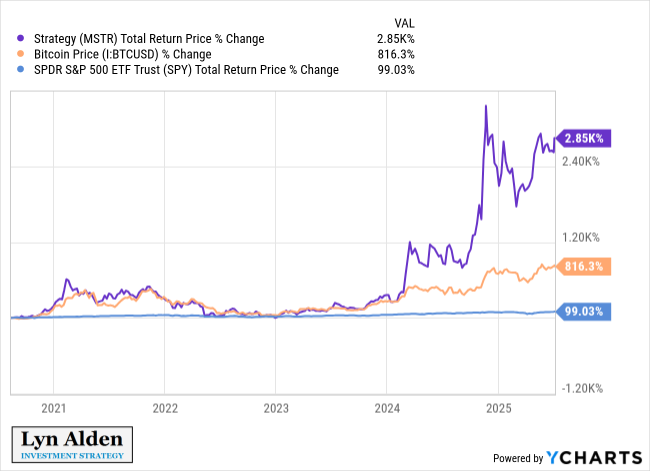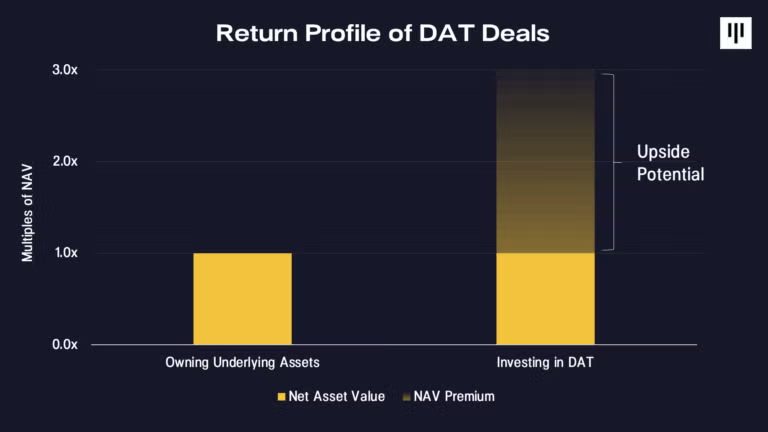In 2025, there has been a sharp increase in companies using Bitcoin as a reserve asset, which has led to the rise of Bitcoin-related stocks and bonds. Fund manager Lyn Alden pointed out two main reasons behind this trend.
These reasons reflect institutional demand and highlight the strategic advantages companies derive from leveraging Bitcoin.
Reason 1: A Substitute for Investment-Restricted Funds
One key reason Lyn Alden mentioned is the limitation many investment funds face. Several funds are only allowed to invest in stocks or bonds and are prohibited from directly buying Bitcoin or cryptocurrency-related ETFs.
As a result, this creates a significant barrier for fund managers who want exposure to Bitcoin—especially those who believe in its strong growth potential. To bypass this restriction, stocks of Bitcoin-holding companies like Strategy (formerly MicroStrategy) (MSTR) have become a valid alternative.

A chart provided by Lyn Alden shows MSTR’s total price return from 2021 to mid-2025 at 2,850%. Bitcoin (BTC/USD) rose 816.3% during the same period, while SPY increased by only 99.03%. This suggests that MSTR outperformed the broader equity market and served as an indirect way for funds to gain Bitcoin exposure.
“In short, there are many funds, due to mandates, that can only own stocks or bonds with bitcoin exposure; not ETFs or similar securities. Bitcoin treasury corporations give them access,” Lyn Alden explained.
She also shared her personal experience managing her model portfolio. In 2020, she chose MSTR because her exchange platform didn’t support direct Bitcoin or GBTC purchases. This flexibility enabled funds with strategy restrictions to gain Bitcoin exposure without violating rules.
Reason 2: The Advantage of Long-Term Bonds and Safer Leverage
Lyn Alden emphasized the second reason: companies’ ability to issue long-term bonds. This helps them avoid the margin call risk that hedge funds often face.
Hedge funds typically use margin borrowing, which can trigger forced asset sales when Bitcoin prices fall sharply.
In contrast, companies like Strategy can issue multi-year bonds. This allows them to hold their Bitcoin positions even during volatile market conditions.
This approach creates a safer form of leverage. It helps companies more effectively capitalize on Bitcoin’s price swings than leveraged ETFs.
Lyn Alden pointed out that long-term bonds offer greater resilience against volatility than margin loans. Companies are not forced to liquidate during short-term downturns.
“This type of longer-duration corporate leverage is also usually better in the long run than leveraged ETFs. Since leveraged ETFs don’t use long-term debt, their leverage resets daily, and so volatility is often quite bad for them,” she added.
Investors Are Increasingly Interested in DATs
Lyn Alden’s insights shed light on the growing investor interest in the stocks of companies embracing strategic crypto reserves.
A recent report from Pantera Capital highlighted that Digital Asset Treasury stocks (DATs) bridge traditional finance and digital assets. They allow investors to gain exposure through familiar instruments.
Pantera also believes investing in DATs could generate higher returns than the underlying digital assets.

“The game has changed after Coinbase gets included in S&P500. Every tradfi PM is hungry and forced to add some digital assets. It’s DAT season, not alts season… The trend is still in the early stage,” investor Nachi commented.
Additionally, a recent BeInCrypto report shows that during this altcoin winter, the stocks of crypto-focused companies like Coinbase, Circle, and Robinhood are outperforming major tokens.
However, this shift in investor focus toward external profit opportunities may cause the crypto industry to lose its growth momentum.
 beincrypto.com
beincrypto.com